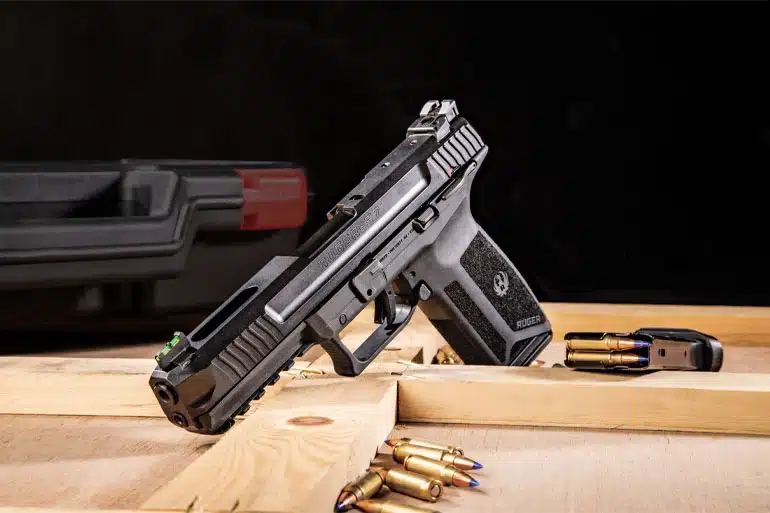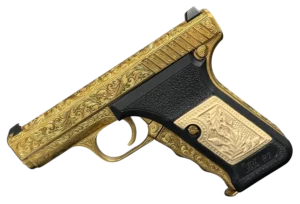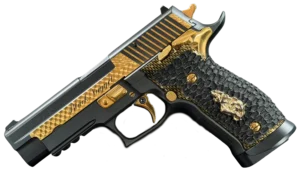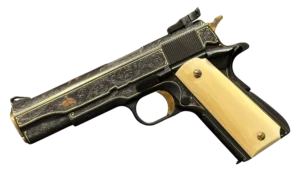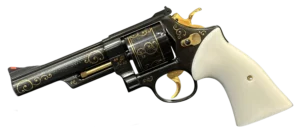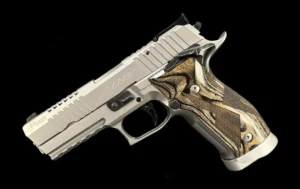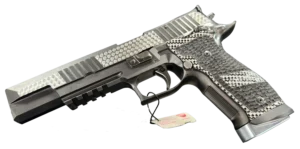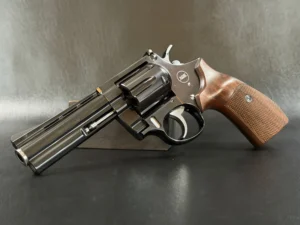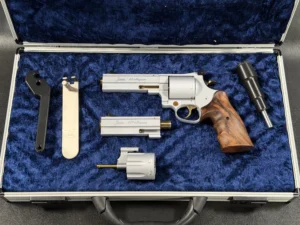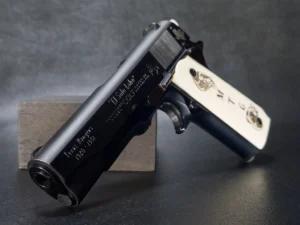The story of Ruger, officially known as Sturm, Ruger & Co., Inc., begins with its founding in 1949 by William B. Ruger and Alexander McCormick Sturm. With a vision to create innovative and quality firearms, Ruger’s journey started in a small rented machine shop in Southport, Connecticut. William Ruger’s expertise in gun design and Sturm’s financial investment laid the cornerstone for what would become a hallmark of American firearm manufacturing.
Ruger’s initial success was driven by their first product, the Ruger Standard, a .22 caliber semi-automatic pistol. This model was notable for its design innovation, combining elements from the German Luger and the Japanese Nambu pistols. The Ruger Standard set the tone for the company’s future – a commitment to producing reliable, high-quality firearms at an affordable price. This guiding principle resonated with American gun enthusiasts, setting Ruger on a path of rapid growth and industry recognition.
Both triumph and tragedy marked the early years. The sudden death of co-founder Alexander Sturm in 1951 profoundly impacted the company, leading to the adoption of the now-famous red eagle logo as a tribute. Despite this loss, Ruger continued expanding its product line, delving into different firearm categories and continuously innovating in design and manufacturing techniques.
Ruger’s dedication to craftsmanship, a unique approach to engineering, and a keen understanding of market needs positioned the company as a leader in the American firearms industry. The foundation laid in these early years would pave the way for decades of excellence, making Ruger a household name among gun enthusiasts.
Innovations and Contributions to the Firearms Industry
A series of innovative designs and manufacturing advancements mark Ruger’s impact on the firearms industry. One of the company’s most significant contributions is its investment in precision casting, also known as investment casting or lost wax casting. This process, adopted by Ruger in the early years, allowed for the cost-effective production of complex gun parts with minimal waste and high precision. This technique set Ruger apart in manufacturing efficiency and enabled them to maintain high-quality standards while keeping their firearms affordable.
Regarding product innovation, Ruger has a history of designing firearms that combine traditional aesthetics with modern functionality. A prime example is the Ruger Mini-14, introduced in 1973. This lightweight semi-automatic rifle, inspired by the military’s M-14, gained popularity for its simplicity, reliability, and versatility, becoming a favorite among ranchers, law enforcement, and recreational shooters.
Another notable innovation is the Ruger Super Redhawk, a powerful double-action revolver introduced in the late 1980s. Designed primarily for hunting and silhouette shooting, the Super Redhawk is renowned for its robust construction, accuracy, and ability to handle heavy, high-velocity cartridges. This revolver exemplifies Ruger’s ability to cater to niche markets, providing high-quality options for specific shooting disciplines.
Ruger’s commitment to innovation is also evident in their approach to safety and user-friendliness. The development of the Ruger Safety System, featured in their firearms, showcases their dedication to producing guns that are not only high-performing but also safe for users. This focus on safety and ongoing advancements in design and functionality demonstrates Ruger’s role as a forward-thinking leader in the firearms industry.
Through these contributions, Ruger has solidified its reputation as a manufacturer that doesn’t just follow market trends but often sets them, continually pushing the boundaries of what is possible in firearm design and manufacturing.
Ruger’s Role in Modern Sporting and Defense Firearms
Ruger’s influence extends prominently into modern sporting and defense firearms, where the company has consistently demonstrated its adaptability and responsiveness to market demands. One of the standout products in this category is the Ruger AR-556, the company’s interpretation of the classic AR-15 platform. Introduced in the 21st century, the AR-556 exemplifies Ruger’s ability to balance traditional design elements with modern shooting preferences. This semi-automatic rifle, known for its reliability, affordability, and versatility, quickly became a favorite among sports shooters, hunters, and those seeking a dependable home defense firearm.
Additionally, Ruger’s entry into the field of compact and concealed carry handguns marked a significant contribution to personal defense weaponry. The Ruger LCP (Lightweight Compact Pistol), introduced in 2008, set a new standard in the concealed carry market with its ultra-lightweight design, reliability, and affordability. Its immediate popularity spurred a wave of similar compact designs across the industry, showcasing Ruger’s influence and foresight in firearm trends.
Ruger’s commitment to sporting and defense firearms is further underscored by its continuous improvement and expansion of product lines. The company’s ability to integrate customer feedback into its design process has resulted in weapons that not only meet but often exceed user expectations regarding performance, safety, and ease of use. Through these endeavors, Ruger has cemented its position as a key player in shaping the landscape of modern sporting and defense firearms.
Ruger’s Impact on the American Gun Culture and Economy
Ruger’s influence extends beyond the manufacturing of firearms; the company has played a pivotal role in shaping American gun culture and contributing to the economy. As a prominent American gun maker, Ruger has advocated for responsible gun ownership and usage. Their involvement in educational programs and partnerships with shooting sports organizations has helped promote accountable and safe firearm handling and usage nationwide.
Economically, Ruger is a significant contributor to the American manufacturing sector. The company’s commitment to producing its firearms entirely in the United States, across its New Hampshire, Arizona, and North Carolina plants showcases its dedication to American craftsmanship and labor. This has not only resulted in the creation of thousands of jobs but has also stimulated local economies and reinforced the importance of domestic manufacturing in a globalized world.
Ruger’s commitment to American values is further exemplified by their active participation in legislative discussions and advocacy for the Second Amendment. Their engagement in these dialogues ensures that the interests of firearms manufacturers and users are represented, contributing to a balanced discourse on gun rights and regulations in the United States.
Through these actions, Ruger has become more than just a firearms manufacturer; they have evolved into a symbol of American tradition, innovation, and economic resilience, deeply ingrained in American society and culture.
The Future of Ruger: Innovations and Market Trends
Looking towards the future, Ruger’s trajectory is firmly aligned with innovation and adaptation to evolving market trends. The company’s recent forays into advanced manufacturing technologies, such as 3D printing and automated machining, signal its commitment to staying at the forefront of firearm manufacturing technology. These advancements promise increased efficiency and precision in production and open doors to new design possibilities and customization options for consumers.
Ruger’s product development strategy also indicates a keen awareness of changing consumer preferences and market dynamics. The growing interest in modular and customizable firearms will likely guide future product designs, allowing users to tailor their weapons to specific needs and preferences. Additionally, the increasing emphasis on innovative gun technology, such as user recognition and tracking systems, may shape Ruger’s research and development efforts, aligning with broader trends toward enhanced firearm safety and accountability.
Furthermore, Ruger’s expansion into new market segments, including younger and more diverse demographics, suggests a strategic approach to broadening its customer base. This may involve introducing new products and engaging in marketing and educational initiatives that resonate with these emerging segments of gun owners.
As Ruger navigates these future trends and challenges, their enduring commitment to quality, innovation, and American manufacturing excellence will undoubtedly continue to position them as a leader in the firearms industry, driving forward the legacy of modern firearm excellence.
Frequently Asked Questions
Sturm, Ruger & Co., Inc., commonly known as Ruger, was founded in 1949 by William B. Ruger and Alexander McCormick Sturm.
Ruger has committed to safety and user-friendliness by incorporating transfer bar mechanisms and integrated safety devices into their firearm designs, enhancing the overall shooting experience.
Ruger adopted precision casting, also known as investment or lost wax casting, in its early years. This process allowed for the cost-effective production of complex gun parts with minimal waste and high precision, enabling Ruger to maintain high-quality standards while keeping their firearms affordable.


